VOLVO XC90 TWIN ENGINE HYBRID 2017 Owners Manual
Manufacturer: VOLVO, Model Year: 2017, Model line: XC90 TWIN ENGINE HYBRID, Model: VOLVO XC90 TWIN ENGINE HYBRID 2017Pages: 584, PDF Size: 14.2 MB
Page 481 of 584
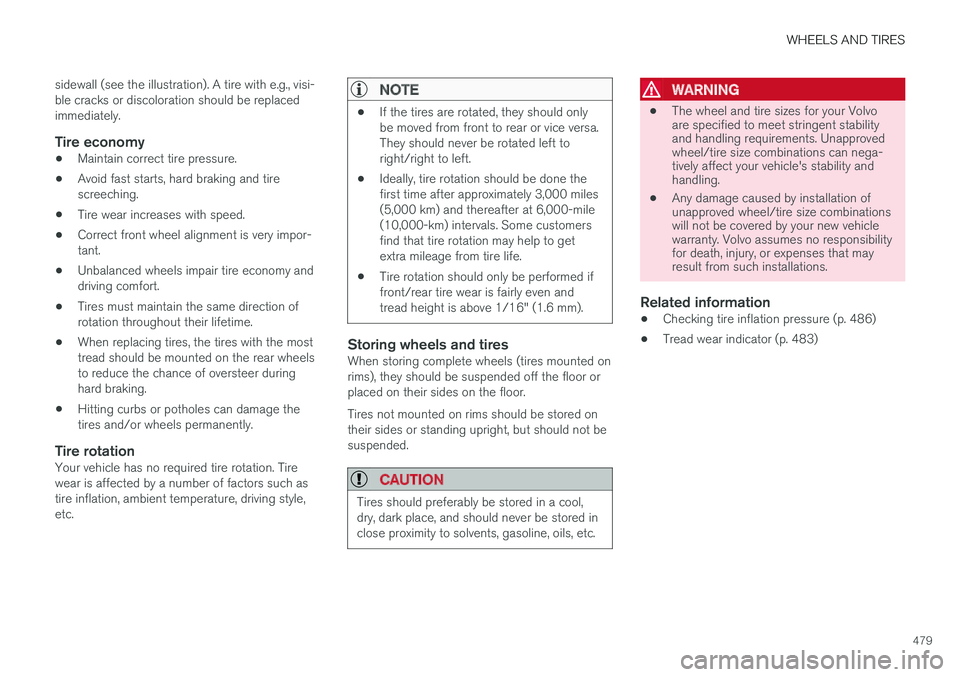
WHEELS AND TIRES
479
sidewall (see the illustration). A tire with e.g., visi-ble cracks or discoloration should be replacedimmediately.
Tire economy
•Maintain correct tire pressure.
•Avoid fast starts, hard braking and tirescreeching.
•Tire wear increases with speed.
•Correct front wheel alignment is very impor-tant.
•Unbalanced wheels impair tire economy anddriving comfort.
•Tires must maintain the same direction ofrotation throughout their lifetime.
•When replacing tires, the tires with the mosttread should be mounted on the rear wheelsto reduce the chance of oversteer duringhard braking.
•Hitting curbs or potholes can damage thetires and/or wheels permanently.
Tire rotation
Your vehicle has no required tire rotation. Tirewear is affected by a number of factors such astire inflation, ambient temperature, driving style,etc.
NOTE
•If the tires are rotated, they should onlybe moved from front to rear or vice versa.They should never be rotated left toright/right to left.
•Ideally, tire rotation should be done thefirst time after approximately 3,000 miles(5,000 km) and thereafter at 6,000-mile(10,000-km) intervals. Some customersfind that tire rotation may help to getextra mileage from tire life.
•Tire rotation should only be performed iffront/rear tire wear is fairly even andtread height is above 1/16" (1.6 mm).
Storing wheels and tires
When storing complete wheels (tires mounted onrims), they should be suspended off the floor orplaced on their sides on the floor.
Tires not mounted on rims should be stored ontheir sides or standing upright, but should not besuspended.
CAUTION
Tires should preferably be stored in a cool,dry, dark place, and should never be stored inclose proximity to solvents, gasoline, oils, etc.
WARNING
•The wheel and tire sizes for your Volvoare specified to meet stringent stabilityand handling requirements. Unapprovedwheel/tire size combinations can nega-tively affect your vehicle's stability andhandling.
•Any damage caused by installation ofunapproved wheel/tire size combinationswill not be covered by your new vehiclewarranty. Volvo assumes no responsibilityfor death, injury, or expenses that mayresult from such installations.
Related information
•Checking tire inflation pressure (p. 486)
•Tread wear indicator (p. 483)
Page 482 of 584
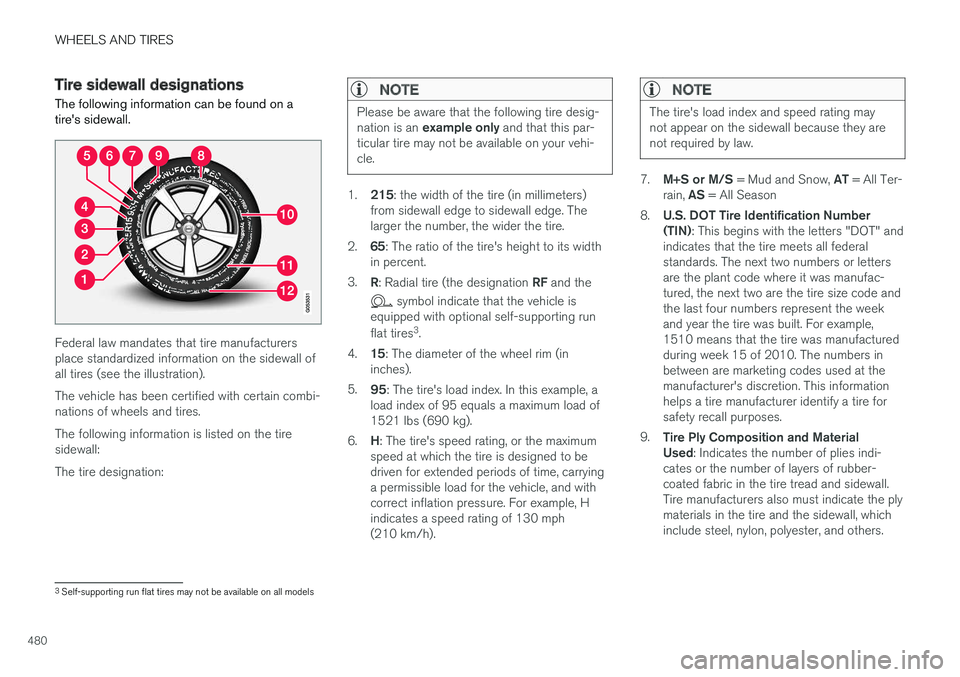
WHEELS AND TIRES
480
Tire sidewall designations
The following information can be found on atire's sidewall.
Federal law mandates that tire manufacturersplace standardized information on the sidewall ofall tires (see the illustration).
The vehicle has been certified with certain combi-nations of wheels and tires.
The following information is listed on the tiresidewall:
The tire designation:
NOTE
Please be aware that the following tire desig-nation is an example only and that this par-ticular tire may not be available on your vehi-cle.
1.215: the width of the tire (in millimeters)from sidewall edge to sidewall edge. Thelarger the number, the wider the tire.
2.65: The ratio of the tire's height to its widthin percent.
3.R: Radial tire (the designation RF and the
symbol indicate that the vehicle isequipped with optional self-supporting run
flat tires3.
4.15: The diameter of the wheel rim (ininches).
5.95: The tire's load index. In this example, aload index of 95 equals a maximum load of1521 lbs (690 kg).
6.H: The tire's speed rating, or the maximumspeed at which the tire is designed to bedriven for extended periods of time, carryinga permissible load for the vehicle, and withcorrect inflation pressure. For example, Hindicates a speed rating of 130 mph(210 km/h).
NOTE
The tire's load index and speed rating maynot appear on the sidewall because they arenot required by law.
7.M+S or M/S = Mud and Snow, AT = All Ter-rain, AS = All Season
8.U.S. DOT Tire Identification Number(TIN): This begins with the letters "DOT" andindicates that the tire meets all federalstandards. The next two numbers or lettersare the plant code where it was manufac-tured, the next two are the tire size code andthe last four numbers represent the weekand year the tire was built. For example,1510 means that the tire was manufacturedduring week 15 of 2010. The numbers inbetween are marketing codes used at themanufacturer's discretion. This informationhelps a tire manufacturer identify a tire forsafety recall purposes.
9.Tire Ply Composition and MaterialUsed: Indicates the number of plies indi-cates or the number of layers of rubber-coated fabric in the tire tread and sidewall.Tire manufacturers also must indicate the plymaterials in the tire and the sidewall, whichinclude steel, nylon, polyester, and others.
3Self-supporting run flat tires may not be available on all models
Page 483 of 584
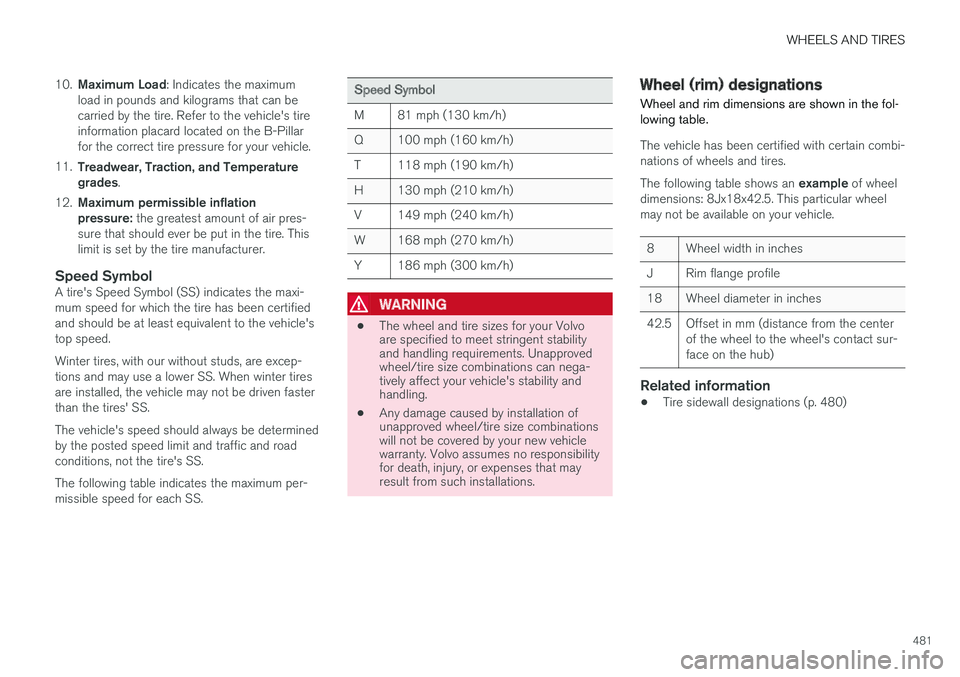
WHEELS AND TIRES
481
10.Maximum Load: Indicates the maximumload in pounds and kilograms that can becarried by the tire. Refer to the vehicle's tireinformation placard located on the B-Pillarfor the correct tire pressure for your vehicle.
11.Treadwear, Traction, and Temperaturegrades.
12.Maximum permissible inflationpressure: the greatest amount of air pres-sure that should ever be put in the tire. Thislimit is set by the tire manufacturer.
Speed Symbol
A tire's Speed Symbol (SS) indicates the maxi-mum speed for which the tire has been certifiedand should be at least equivalent to the vehicle'stop speed.
Winter tires, with our without studs, are excep-tions and may use a lower SS. When winter tiresare installed, the vehicle may not be driven fasterthan the tires' SS.
The vehicle's speed should always be determinedby the posted speed limit and traffic and roadconditions, not the tire's SS.
The following table indicates the maximum per-missible speed for each SS.
Speed Symbol
M81 mph (130 km/h)
Q100 mph (160 km/h)
T118 mph (190 km/h)
H130 mph (210 km/h)
V149 mph (240 km/h)
W168 mph (270 km/h)
Y186 mph (300 km/h)
WARNING
•The wheel and tire sizes for your Volvoare specified to meet stringent stabilityand handling requirements. Unapprovedwheel/tire size combinations can nega-tively affect your vehicle's stability andhandling.
•Any damage caused by installation ofunapproved wheel/tire size combinationswill not be covered by your new vehiclewarranty. Volvo assumes no responsibilityfor death, injury, or expenses that mayresult from such installations.
Wheel (rim) designations
Wheel and rim dimensions are shown in the fol-lowing table.
The vehicle has been certified with certain combi-nations of wheels and tires.
The following table shows an example of wheeldimensions: 8Jx18x42.5. This particular wheelmay not be available on your vehicle.
8Wheel width in inches
JRim flange profile
18Wheel diameter in inches
42.5Offset in mm (distance from the centerof the wheel to the wheel's contact sur-face on the hub)
Related information
•Tire sidewall designations (p. 480)
Page 484 of 584

WHEELS AND TIRES
482
Tire terminology
The following is a glossary of tire-related terms.
The tire suppliers may have additional markings,notes or warnings such as standard load, radialtubeless, etc.
•Tire information placard: A placard show-ing the OE (Original Equipment) tire sizes,recommended inflation pressure, and themaximum weight the vehicle can carry.
•Tire Identification Number (TIN): A numberon the sidewall of each tire providing infor-mation about the tire brand and manufactur-ing plant, tire size and date of manufacturer.
•Inflation pressure: A measure of theamount of air in a tire.
•Standard load: A class of P-metric or Metrictires designed to carry a maximum load at35 psi [37 psi (2.5 bar) for Metric tires].Increasing the inflation pressure beyond thispressure will not increase the tires load car-rying capability.
•Extra load: A class of P-metric or Metrictires designed to carry a heavier maximumload at 41 psi [43 psi (2.9 bar) for Metrictires]. Increasing the inflation pressurebeyond this pressure will not increase thetire's load carrying capability.
•kPa: Kilopascal, a metric unit of air pressure.
•PSI: Pounds per square inch, a standard unitof air pressure.
•B-pillar: The structural member at the sideof the vehicle behind the front door.
•Bead area of the tire: Area of the tire nextto the rim.
•Sidewall of the tire: Area between the beadarea and the tread.
•Tread area of the tire: Area of the perime-ter of the tire that contacts the road whenmounted on the vehicle.
•Rim: The metal support (wheel) for a tire or atire and tube assembly upon which the tirebeads are seated.
•Maximum load rating: a figure indicatingthe maximum load in pounds and kilogramsthat can be carried by the tire. This rating isestablished by the tire manufacturer.
•Maximum permissible inflation pressure:the greatest amount of air pressure thatshould ever be put in the tire. This limit is setby the tire manufacturer.
•Recommended tire inflation pressure:inflation pressure, established by Volvo,which is based on the type of tires that aremounted on a vehicle at the factory. Thisinformation can be found on the tire inflationplacard(s) located on the driver's side B-pillarand in the tire inflation table in this chapter.
•Cold tires: The tires are considered to becold when they have the same temperatureas the surrounding (ambient) air. This tem-
perature is normally reached after the vehiclehas been parked for at least 3 hours.
Page 485 of 584
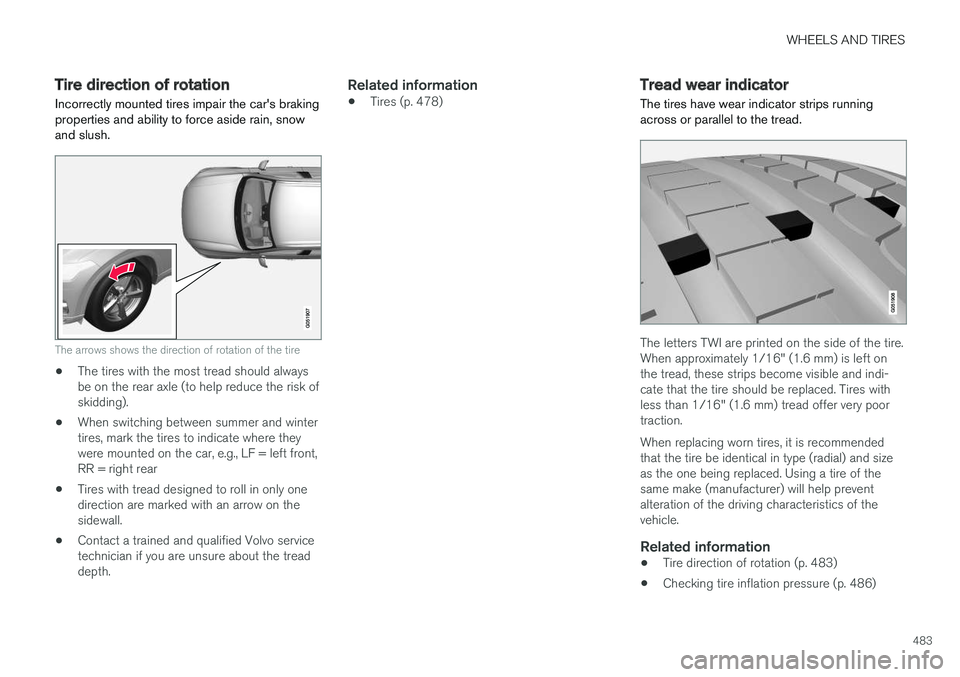
WHEELS AND TIRES
483
Tire direction of rotation
Incorrectly mounted tires impair the car's brakingproperties and ability to force aside rain, snowand slush.
The arrows shows the direction of rotation of the tire
•The tires with the most tread should alwaysbe on the rear axle (to help reduce the risk ofskidding).
•When switching between summer and wintertires, mark the tires to indicate where theywere mounted on the car, e.g., LF = left front,RR = right rear
•Tires with tread designed to roll in only onedirection are marked with an arrow on thesidewall.
•Contact a trained and qualified Volvo servicetechnician if you are unsure about the treaddepth.
Related information
•Tires (p. 478)Tread wear indicator
The tires have wear indicator strips runningacross or parallel to the tread.
The letters TWI are printed on the side of the tire.When approximately 1/16" (1.6 mm) is left onthe tread, these strips become visible and indi-cate that the tire should be replaced. Tires withless than 1/16" (1.6 mm) tread offer very poortraction.
When replacing worn tires, it is recommendedthat the tire be identical in type (radial) and sizeas the one being replaced. Using a tire of thesame make (manufacturer) will help preventalteration of the driving characteristics of thevehicle.
Related information
•Tire direction of rotation (p. 483)
•Checking tire inflation pressure (p. 486)
Page 486 of 584
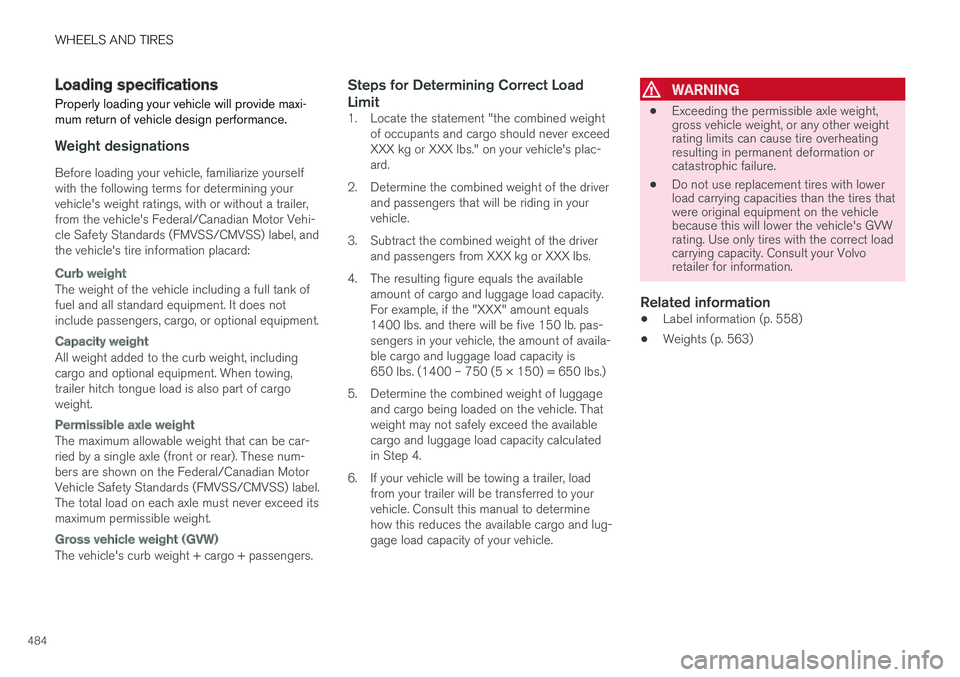
WHEELS AND TIRES
484
Loading specifications
Properly loading your vehicle will provide maxi-mum return of vehicle design performance.
Weight designations
Before loading your vehicle, familiarize yourselfwith the following terms for determining yourvehicle's weight ratings, with or without a trailer,from the vehicle's Federal/Canadian Motor Vehi-cle Safety Standards (FMVSS/CMVSS) label, andthe vehicle's tire information placard:
Curb weight
The weight of the vehicle including a full tank offuel and all standard equipment. It does notinclude passengers, cargo, or optional equipment.
Capacity weight
All weight added to the curb weight, includingcargo and optional equipment. When towing,trailer hitch tongue load is also part of cargoweight.
Permissible axle weight
The maximum allowable weight that can be car-ried by a single axle (front or rear). These num-bers are shown on the Federal/Canadian MotorVehicle Safety Standards (FMVSS/CMVSS) label.The total load on each axle must never exceed itsmaximum permissible weight.
Gross vehicle weight (GVW)
The vehicle's curb weight + cargo + passengers.
Steps for Determining Correct Load
Limit
1. Locate the statement "the combined weightof occupants and cargo should never exceedXXX kg or XXX lbs." on your vehicle's plac-ard.
2. Determine the combined weight of the driverand passengers that will be riding in yourvehicle.
3. Subtract the combined weight of the driverand passengers from XXX kg or XXX lbs.
4. The resulting figure equals the availableamount of cargo and luggage load capacity.For example, if the "XXX" amount equals1400 lbs. and there will be five 150 lb. pas-sengers in your vehicle, the amount of availa-ble cargo and luggage load capacity is650 lbs. (1400 – 750 (5 × 150) = 650 lbs.)
5. Determine the combined weight of luggageand cargo being loaded on the vehicle. Thatweight may not safely exceed the availablecargo and luggage load capacity calculatedin Step 4.
6. If your vehicle will be towing a trailer, loadfrom your trailer will be transferred to yourvehicle. Consult this manual to determinehow this reduces the available cargo and lug-gage load capacity of your vehicle.
WARNING
•Exceeding the permissible axle weight,gross vehicle weight, or any other weightrating limits can cause tire overheatingresulting in permanent deformation orcatastrophic failure.
•Do not use replacement tires with lowerload carrying capacities than the tires thatwere original equipment on the vehiclebecause this will lower the vehicle's GVWrating. Use only tires with the correct loadcarrying capacity. Consult your Volvoretailer for information.
Related information
•Label information (p. 558)
•Weights (p. 563)
Page 487 of 584

WHEELS AND TIRES
}}
485
Uniform Tire Quality Grading
ALL PASSENGER VEHICLE TIRES MUSTCONFORM TO FEDERAL SAFETY REQUIRE-MENTS IN ADDITION TO THESE GRADES.
Quality grades can be found, where applica-ble, on the tire sidewall between the treadshoulder and maximum section width. Forexample:
Treadwear 200 Traction AA Temperature A
TREADWEAR
The treadwear grade is a comparative ratingbased on the wear rate of the tire when testedunder controlled conditions on a specified gov-ernment test course. For example, a tire graded150 would wear one and one half (1 ½) times aswell on the government course as a tire graded100. The relative performance of tires dependsupon the actual conditions of their use, however,and many depart significantly from the norm dueto variation in driving habits, maintenance practi-ces and differences in road characteristics andclimate.
TRACTION
The traction grades, from highest to lowest, areAA, A, B, and C, as measured under controlledconditions on specified government test surfacesof asphalt and concrete. A tire marked C mayhave poor traction performance. The tractiongrade assigned to this tire is based on braking
(straight-ahead) traction tests and is not a meas-ure of cornering (turning) traction.
WARNING
The traction grade assigned to this tire isbased on braking (straight-ahead) tractiontests and is not a measure of cornering (turn-ing) traction.
TEMPERATURE
The temperature grades are A (the highest), B,and C, representing the tire's resistance to thegeneration of heat and its ability to dissipate heatwhen tested under controlled conditions on aspecified indoor laboratory test wheel. Sustainedhigh temperature can cause the material of thetire to degenerate and reduce tire life, and exces-sive temperature can lead to sudden tire failure.The grade C corresponds to a minimum level ofperformance that all passenger vehicle tires mustmeet under the Federal Motor Safety StandardNo. 109. Grades B and A represent higher levelsof performance on the laboratory test wheel thanthe minimum required by law.
WARNING
The temperature grade for this tire is estab-lished for a tire that is properly inflated andnot overloaded. Excessive speed, under-infla-tion, or excessive loading, either separately orin combination, can cause heat buildup andtire failure.
Snow tires and chains
The use of snow chains and/or winter tires canhelp improve traction in winter driving conditions.
Snow chains can be used on your Volvo with thefollowing restrictions:
•Snow chains should be installed on frontwheels only. Use only Volvo approved snowchains.
•If accessory, aftermarket or "custom" tiresand wheels are installed and are of a size dif-ferent than the original tires and wheels,chains in some cases CANNOT be used.Sufficient clearances between chains andbrakes, suspension and body componentsmust be maintained.
•Some strap-on type chains will interfere withbrake components and therefore CANNOTbe used.
•All Wheel Drive models: Snow chainsshould only be installed on the front wheels.
•Certain size tires may not allow the assemblyof snow chains/traction devices.
Consult your Volvo retailer for additional snowchain information.
Page 488 of 584
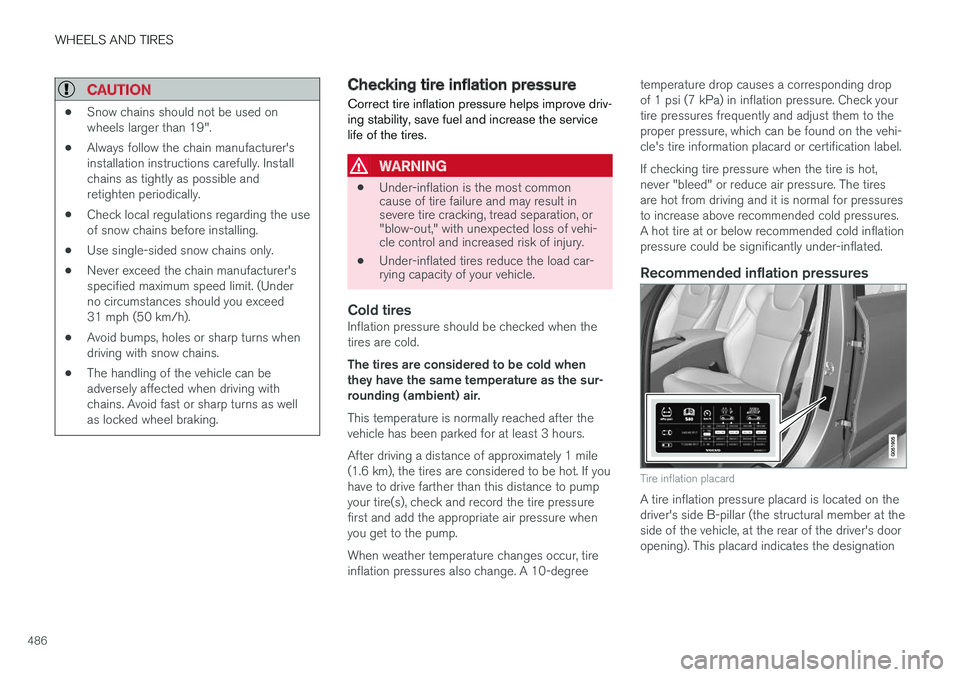
WHEELS AND TIRES
486
CAUTION
•Snow chains should not be used onwheels larger than 19".
•Always follow the chain manufacturer'sinstallation instructions carefully. Installchains as tightly as possible andretighten periodically.
•Check local regulations regarding the useof snow chains before installing.
•Use single-sided snow chains only.
•Never exceed the chain manufacturer'sspecified maximum speed limit. (Underno circumstances should you exceed31 mph (50 km/h).
•Avoid bumps, holes or sharp turns whendriving with snow chains.
•The handling of the vehicle can beadversely affected when driving withchains. Avoid fast or sharp turns as wellas locked wheel braking.
Checking tire inflation pressure
Correct tire inflation pressure helps improve driv-ing stability, save fuel and increase the servicelife of the tires.
WARNING
•Under-inflation is the most commoncause of tire failure and may result insevere tire cracking, tread separation, or"blow-out," with unexpected loss of vehi-cle control and increased risk of injury.
•Under-inflated tires reduce the load car-rying capacity of your vehicle.
Cold tires
Inflation pressure should be checked when thetires are cold.
The tires are considered to be cold whenthey have the same temperature as the sur-rounding (ambient) air.
This temperature is normally reached after thevehicle has been parked for at least 3 hours.
After driving a distance of approximately 1 mile(1.6 km), the tires are considered to be hot. If youhave to drive farther than this distance to pumpyour tire(s), check and record the tire pressurefirst and add the appropriate air pressure whenyou get to the pump.
When weather temperature changes occur, tireinflation pressures also change. A 10-degree
temperature drop causes a corresponding dropof 1 psi (7 kPa) in inflation pressure. Check yourtire pressures frequently and adjust them to theproper pressure, which can be found on the vehi-cle's tire information placard or certification label.
If checking tire pressure when the tire is hot,never "bleed" or reduce air pressure. The tiresare hot from driving and it is normal for pressuresto increase above recommended cold pressures.A hot tire at or below recommended cold inflationpressure could be significantly under-inflated.
Recommended inflation pressures
Tire inflation placard
A tire inflation pressure placard is located on thedriver's side B-pillar (the structural member at theside of the vehicle, at the rear of the driver's dooropening). This placard indicates the designation
Page 489 of 584
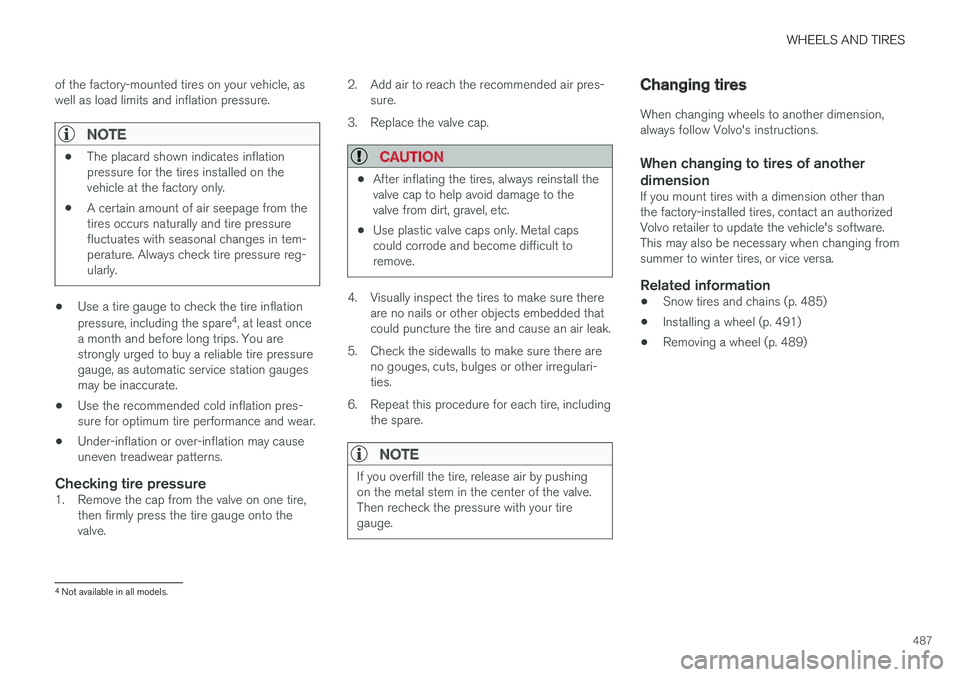
WHEELS AND TIRES
487
of the factory-mounted tires on your vehicle, aswell as load limits and inflation pressure.
NOTE
•The placard shown indicates inflationpressure for the tires installed on thevehicle at the factory only.
•A certain amount of air seepage from thetires occurs naturally and tire pressurefluctuates with seasonal changes in tem-perature. Always check tire pressure reg-ularly.
•Use a tire gauge to check the tire inflation
pressure, including the spare4, at least oncea month and before long trips. You arestrongly urged to buy a reliable tire pressuregauge, as automatic service station gaugesmay be inaccurate.
•Use the recommended cold inflation pres-sure for optimum tire performance and wear.
•Under-inflation or over-inflation may causeuneven treadwear patterns.
Checking tire pressure
1. Remove the cap from the valve on one tire,then firmly press the tire gauge onto thevalve.
2. Add air to reach the recommended air pres-sure.
3. Replace the valve cap.
CAUTION
•After inflating the tires, always reinstall thevalve cap to help avoid damage to thevalve from dirt, gravel, etc.
•Use plastic valve caps only. Metal capscould corrode and become difficult toremove.
4. Visually inspect the tires to make sure thereare no nails or other objects embedded thatcould puncture the tire and cause an air leak.
5.Check the sidewalls to make sure there areno gouges, cuts, bulges or other irregulari-ties.
6. Repeat this procedure for each tire, includingthe spare.
NOTE
If you overfill the tire, release air by pushingon the metal stem in the center of the valve.Then recheck the pressure with your tiregauge.
Changing tires
When changing wheels to another dimension,always follow Volvo's instructions.
When changing to tires of another
dimension
If you mount tires with a dimension other thanthe factory-installed tires, contact an authorizedVolvo retailer to update the vehicle's software.This may also be necessary when changing fromsummer to winter tires, or vice versa.
Related information
•Snow tires and chains (p. 485)
•Installing a wheel (p. 491)
•Removing a wheel (p. 489)
4Not available in all models.
Page 490 of 584
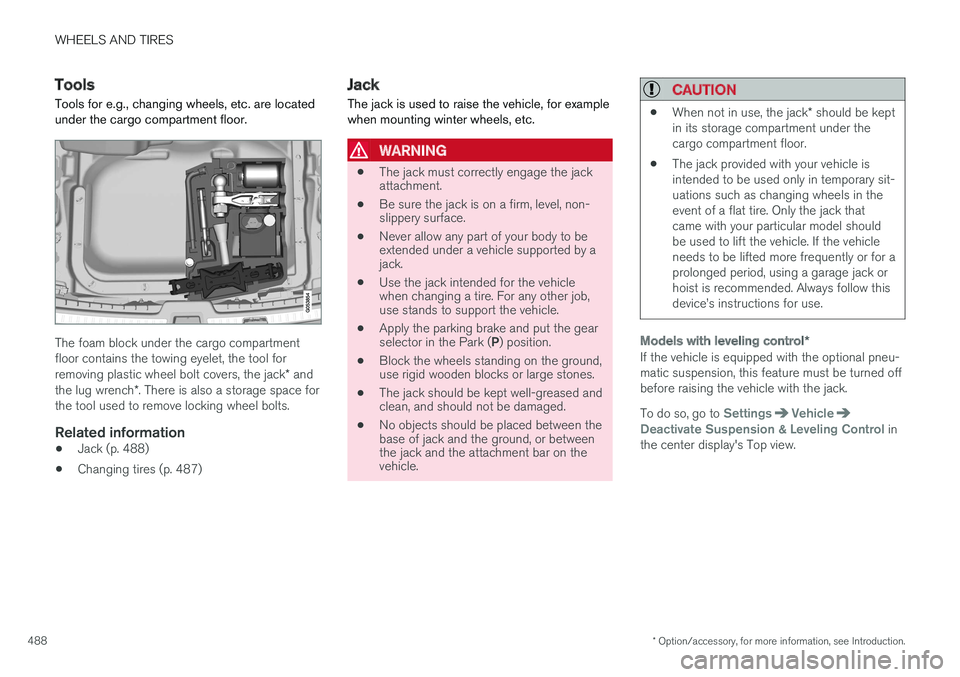
WHEELS AND TIRES
* Option/accessory, for more information, see Introduction.488
Tools
Tools for e.g., changing wheels, etc. are locatedunder the cargo compartment floor.
The foam block under the cargo compartmentfloor contains the towing eyelet, the tool forremoving plastic wheel bolt covers, the jack* andthe lug wrench*. There is also a storage space forthe tool used to remove locking wheel bolts.
Related information
•Jack (p. 488)
•Changing tires (p. 487)
Jack
The jack is used to raise the vehicle, for examplewhen mounting winter wheels, etc.
WARNING
•The jack must correctly engage the jackattachment.
•Be sure the jack is on a firm, level, non-slippery surface.
•Never allow any part of your body to beextended under a vehicle supported by ajack.
•Use the jack intended for the vehiclewhen changing a tire. For any other job,use stands to support the vehicle.
•Apply the parking brake and put the gearselector in the Park (P) position.
•Block the wheels standing on the ground,use rigid wooden blocks or large stones.
•The jack should be kept well-greased andclean, and should not be damaged.
•No objects should be placed between thebase of jack and the ground, or betweenthe jack and the attachment bar on thevehicle.
CAUTION
•When not in use, the jack* should be keptin its storage compartment under thecargo compartment floor.
•The jack provided with your vehicle isintended to be used only in temporary sit-uations such as changing wheels in theevent of a flat tire. Only the jack thatcame with your particular model shouldbe used to lift the vehicle. If the vehicleneeds to be lifted more frequently or for aprolonged period, using a garage jack orhoist is recommended. Always follow thisdevice